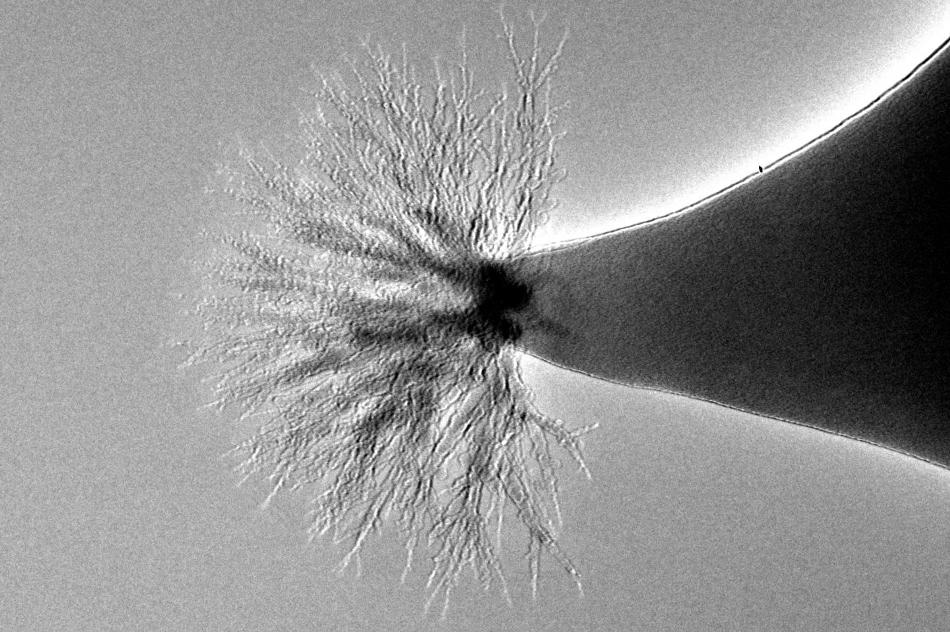Aug 9 2016
Moving a nanosatellite around in space takes only a tiny amount of thrust. Engineers from Michigan Technological University and the University of Maryland teamed up, put a nanoscale rocket under a microscope, and watched what happened.
 The tree-like formations in this molten salt formed under the high-radiation of a transmission electron microscope beam; the jet of ions from the material could serve as a thruster for a nanosatellite (Credit: Michigan Tech, Kurt Terhune)
The tree-like formations in this molten salt formed under the high-radiation of a transmission electron microscope beam; the jet of ions from the material could serve as a thruster for a nanosatellite (Credit: Michigan Tech, Kurt Terhune)
To Infinity and Beyond with Nanosatellites
When a satellite is placed into orbit by a rocket, its journey has only just begun. Released into space on its own, the satellite needs an on-board thruster so it can navigate to its desired location and then remain there despite the many things that do their best to kick it off course.
"Space isn't the empty vacuum of nothingness many of us assume," says Kurt Terhune, a mechanical engineering graduate student and the lead author on a new study published in Nanotechnology this week. "Space actually has a small amount of atmosphere that causes drag, solar winds that push satellites off course and space debris that present a constant hazard."
This is especially important in the new era of space exploration. Dozens of companies plan to launch thousands of tiny satellites—some as small as shoe boxes—within the next five years. Each of these nanosatellites will need its own tiny thruster. One solution comes in the form of an electrospray thruster that Terhune studies along with his advisor, L. Brad King, the Ron and Elaine Starr Professor of Space Systems Engineering. The propellants for these thrusters are called “ionic liquids,” which are room-temperature liquid salts.
"Much like the sodium chloride table salt many of us enjoy on French fries, ionic liquids are comprised of roughly equal numbers of positively and negatively charged ions," Terhune says, explaining that electric fields, supplied by spacecraft batteries, can exert forces on these ions and eject them into space at great velocity. The emitted ion beam can provide the gentle thrust that the nanosatellite needs.
Electrospray Engines
Many of these tiny electrospray thrusters packed together could propel a spacecraft over great distances, maybe even to the nearest exoplanet. Electrospray thrusters are currently being tested on the European Space Agency’s LISA Pathfinder, which hopes to poise objects in space so precisely that they would only be disturbed by gravitational waves.
But these droplet engines have a problem: sometimes they form needle-like spikes that disrupt the way the thruster works—they get in the way of the ions flowing outward and turn the liquid to solid. Terhune and King wanted to find out how this actually happens.
"The challenge is obtaining images of a material in the presence of such a strong electric field, which is why we turned to John Cumings at the University of Maryland," King says, explaining that Cumings is known for his work with challenging materials. To make things harder, the tip of the droplet can move around by a few microns while the thruster is operating. A few microns is a small distance, but compared with the features that the team needed to observe, this made the experiment like trying to find a needle in a haystack.
"Finding the actual nano-scale tip of the droplet with an electron microsope is like trying to look through a soda straw to find a penny somewhere on the floor of a room," King says. "And if that penny moves, like the tip of the molten salt droplet does—then it's off camera, and you have to start searching all over again."
At the Advanced Imaging and Microscopy Lab at the University of Maryland, Cumings put the tiny thruster in a transmission electron microscope (TEM)—an advanced scope that can see things down to millionths of a meter. They watched as the droplet elongated and sharpened to a point, and then started emitting ions. Then the tree-like defects began to appear.
Back in Orbit
The researchers say that figuring out why these branched structures grow could help prevent them from forming. The problem occurs as the microscope's high-energy electron beam exposes the fluid to radiation, breaking some of the bonds between atoms in the ions. This damages the molten salt's molecular structure, so it gels and piles up.
"We were able to watch the dendritic structures accumulate in real time," Terhune says. "The specific mechanism still needs to be investigated, but this could have importance for spacecraft in high-radiation environments."
He adds that the microscope's electron beam is more powerful than natural settings, but the gelling could affect the lifetime of electrospray engines in deep space and geosynchronous orbits where most of the planet's satellites circle. And you don't have to be a rocket scientist to know figuring out the physics to improve that lifetime is a good idea.